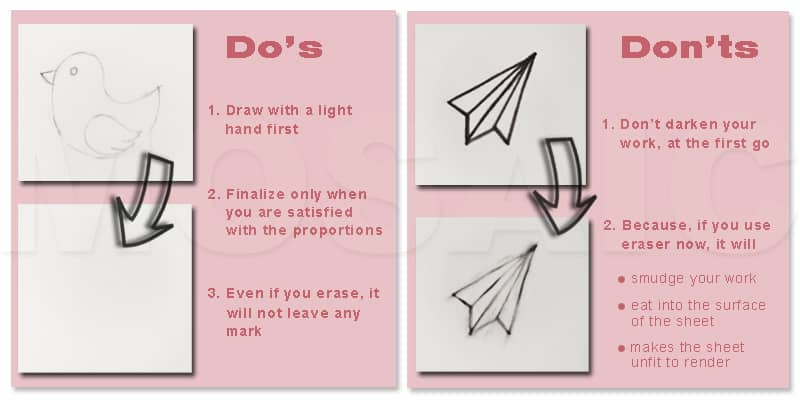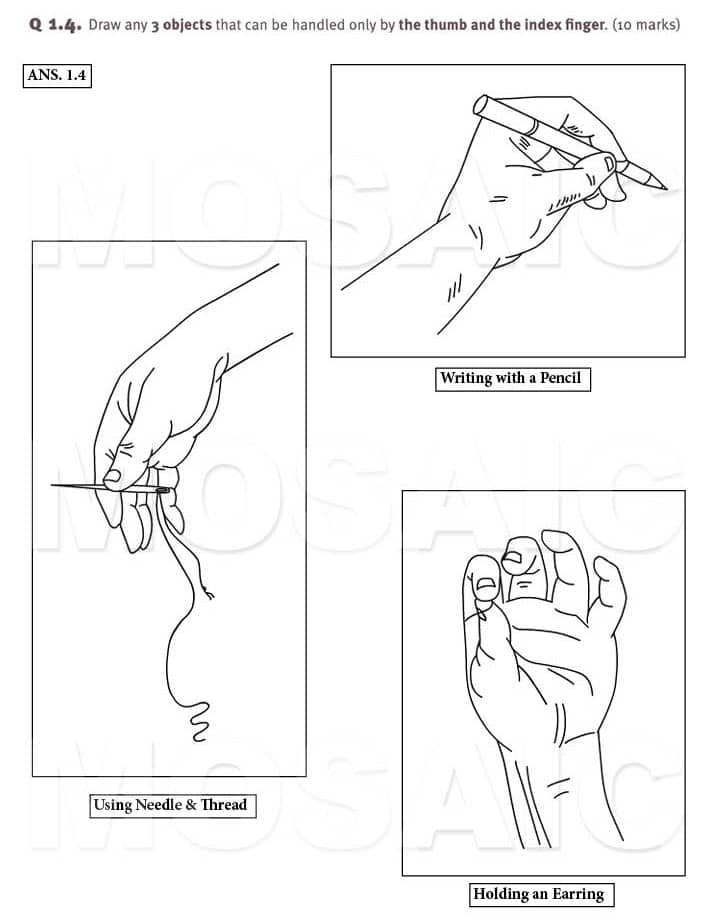How to Prepare for NID?
[21 Valuable Tips to Crack the Toughest Design Exam in India]
These are the 21 most Valuable and Practical tips for NID preparation
So, if you are also NID Aspirant, you'll love these awesome tips and use them for NID exam preparation.
But, before we dive in, first understand the exam preparation strategy
Table of Contents
NID DAT Preparation Tips
1. When to start preparing for NID?
2. How Important are Drawing Skills for NID Exam?
11. Solve Previous Year Papers of NID
NID DAT PREPARATION TIPS (Prelims)
Tip No 1. When to start preparing for NID?
First understand, that NID entrance is very different from other exams.
So, theory or mugging from books, is not going to help much.
An aspiring candidate has to work on inherent qualities like creativity, observation, imagination and visualization skills.
Now, everyone understands that these qualities can't be developed in a short period of time.
So, if you wish to be a designer when you grow up, it's advisable to work on your aptitude when you are young.
This does not mean that you join coaching classes of NID, but start slowly by exploring the field and works of other great designers.
Keep a sketchbook with you, develop an habit of scribbling whenever an idea comes to you (even if it seems silly at that point)
Come back to your ideas later and see if you can add more to them and develop them further.
This is one small example on how you can start your journey towards becoming a designer.
Develop a genuine passion for the field, that is really going to help.
Tip No 2. How Important are Drawing Skills for NID Exam?
The most common misconception among NID aspirants is that if you draw well, then you can crack NID, which is totally false.
Good sketching skills are essential, as it helps a candidate to communicate his/her ideas to the examiner.
But there is more to design exams than evaluating candidates on how nicely they can draw !!
The questions are framed to judge a candidate's creativity, imagination & visualization skills, observation, general awareness etc.
The following question has been picked up from my blogpost "4 Variations to Answer NID Drawing Questions"
It's from one of the previous year papers of NID.
The question says......
Ques. Draw a dog with human figure, in proportion in any relevant posture
.jpg)
The 4 options are an effort to explore different options to answer a single question
So, developing skills like creativity, imagination & visualization, observation, general awareness are equally important.
Along with improving one's drawing skills, NID Aspirants also need to focus on the above mentioned skills.
Some candidate's are naturally gifted in the above skills, while others need to work hard to develop them.
The early you start, better for you!!
The following articles might help:
| How to improve your chances to crack NID , Part 1 | Finding Faces: Creative Exercise for NID Preparation |
| 5 Everyday Objects You Can Use To Prepare For NID | How to increase your observation skills? |
Tip No 3. Memory Drawing
As per the above point, drawing skills account for just one of the many skills required for the NID exam.
And memory drawing constitutes an important part.
Many students can do excellent copy drawing but find it difficult while drawing from memory.
The only solution is developing observation skills and lots of practice.
Live sketching also helps.
Tip No 4. Technical Drawing
Knowledge of Technical Drawing is also essential.
Technical Drawing or Engineering Drawing is not conventional drawing, that we as kids learn in school.
Learning Technical Drawing is very important.
It covers topics like:
- Perspective Drawing
- Composing 3-Dimensional elements
- Light and Shadow
- Scale and Proportions

Above is an example of Perspective Drawing
Tip No 5. Drawing Straight Lines
Practice drawing freehand straight lines: verticals, horizontals and diagonals.
Draw lots of them.
Avoid using scales, as scales provide an sterility to your drawings.
Instead draw freehand.
Of course, you’ll need a lot of practice to gain confidence.
More to Explore...

NID Study Material
NID Books: Available in Full, Mini, Combo & Test Series Pack. Doorstep delivery across India.
Details
NID eBooks
Study at Home with NID eBooks! Instant Download. Saves Time. Learn at your own pace!
Details
NID Video Packs
NID Video Packs: Engaging Video Lessons supported by E-Books. Instant Downloadable.
Details
NID Mock Tests
Free NID Mock Test based on NID Exam Pattern - Includes Timer, Detailed Results & Answer Key.
DetailsTip No 6. Erasing
Try to use the eraser to the minimum.
Erasing and re-drawing wastes a lot of time, smudges your work and eats into the surface of the catridge sheet making it unfit to render later on.

You can achieve the above, by always drawing with a light hand first.
Only when you are satisfied with the proportions and rough outlines, you should consider finalizing your work.
Tip No 7. Are you Creative Enough?
Creativity is a mysterious trait.
Many people have tried to define creativitiy in their own ways but there is no single universally accepted definition.
It is difficult to summarise in a few lines but we can say that creativity is the ability to come up with new, original ideas which are not conventional.
It is the breaking away from the stereotype, routine, accepted set of thoughts and possessing a deeper insight to problem solving.
In short, a creative person experiences rebirth everyday with his or her ideas. If you think you are not creative enough, don't worry - there are lots of exercises to improve your creative skills.
You can start by simple exercises like playing tangram puzzles.
Also, routine tasks kill creativity, try to give your brain chances to explore new things.
Tip No 8. The Crucial 1 Minute
Before answering a drawing question, at least give yourself 1 minute to plan your composition, before jumping straight to the answer.
Mentally visualize what all elements you wish to include, how you can make the composition more interesting, what all details you wish to include.
Don't underestimate the power of the humble 60 seconds.
This 1 min of planning can help you come up with better views and interesting compositions.
Tip No 9. Speed
Understand that your drawing & creative skills are useless if you are not able to present your thoughts in the exam in the limited amount of time.
You stand to lose marks for the questions you fail to answer or which are left incomplete, it doesn't matter how good you are at your work.
So speed is equally important.
You need to prepare a strategy for the sequence of answering the questions.
See, if you are comfortable answering the subjective questions first or the objective ones and decide on the max time you can allocate for the marks.
A common mistake students make is to devote a lot of time to drawing questions.
Read the instructions carefully, if colouring is not mentioned, don't waste your time doing it.
It's difficult to clear the first phase of NID entrance, if you've left the paper incomplete.
So, before the exams, devote some time attempting Mock NID Tests along with a timer.
Tip No 10. How to use the Pencil?
In questions requiring drawing, you should always give importance to the initial layout / drawing / composition.
This is important, because it very much decides the outcome of your final drawing.
You should always draw with a light hand first, with an HB pencil.
Why am I recommending an HB pencil?
Because corrections are very difficult with B pencils, as they tend to spoil the sheets when erased.
They are best used for rendering purposes.
H pencils are light, but still not a good choice.
This is because, even when drawn with the slightest pressure, they tend to leave a mark on the paper.
And when you erase the initial drawing for correction purpose, the mark is very much visible.
It's even more pronounced when rendered.
So, the initial layout should be done with an HB pencil, doing mainly the outlining without the details.
When you are satisfied with the proportions & the rough outline, you may finalize.
This way, you will save a lot of time that students normally waste in erasing & re-drawing.
Tip No 11. Solve Previous Year Papers of NID
Go through all previous papers of NID.
Solve at least 8 - 10 past papers within the time limit.
Find out a comfortable sequence of answering the paper.
If you are faced with a mental block , breathe deeply, relax and then try to answer the question.
Solving the papers helps you get acquainted with the paper style, but don't expect a predictable pattern.
The paper pattern keeps on changing, which may take the aspiring candidate's by surprise.
More articles on NID Papers:
| NID Sample Papers | NID Question Paper |
| NID Previous Year papers | NID M.Des Paper |
Tip No 12. NID Study Materials
Give a boost to your preparations with NID Study Materials!!
You don’t need to spend a fortune on coaching classes……
In fact you can self-prepare on a budget.
Tip No 13. Human Figures
A lot of students face problems with drawing perfect human figures…
This tip will not work on questions asking for portraits or human postures, but applicable in compositions or perspectives where human figures are one part of the whole drawing.
If you find it difficult to draw human figures, at least get your stick figures or block figures correct.
You will lose some marks for the unfinished figures, but those marks will be miniscule. If the view is correct and the proportions & postures of human figures correct, most examiners will give you marks.

What marks they give is their discretion?
But at least you got a life-saver tip to deal with human figure questions.
Tip No 14. Colouring Mediums
First of all, use your discretion when it comes to rendering drawing questions.
Rendering with colours or even with pencils take a lot of time, and not all questions ask for it.
Understand the context of the question, to decide whether to render your drawing or not.
Even, when you have to do so, always use dry mediums (colours), as they are convenient to use and take less time in exams.
Tip No 15. Read, Re-Read the Question
Most of the students are in a hurry to complete the paper.
A common mistake is to skip the instructions or not read them properly.
It’s very important to read and re-read the questions & instructions.
This is crucial to understand, what exactly the examiners are expecting in your answers.
Let's explain the above with the help of an example......
The below mentioned question is from a previous year paper of NID B Des Dat Prelims.
The question asks the candidate to draw any 3 objects that can be handled only by the thumb and the index finger.
The question is short and non-descriptive.
It is crucial in such a case that the candidate understands exactly what the examiner is expecting in the answer....
As we read and re-read the question, we notice
The words "3 objects" and "the thumb and the index finger" are in bold, clearly highlighted.
Here, you should be able to draw 3 objects that can be handled only by the thumb and the index finger.
What matters in this question is:
- How unique/unconventional the objects are.
- How well you can portray them in the given space in a limited amount of time.
- Precise Heading
What is not required?
- Any Backgrounds
- Rendering or Colouring
- Any detailed description
Your correct understanding of the question is very important to ensure that you answer exactly what is asked and don't waste time on details that are not required.
So, from the given example, you can understand the importance of reading and re-reading the question

Tip No 16. What Stationary to Use?
One question that keeps coming to me again & again is about the choice of stationary to be used for the exam.
A variety of stationary is available in the market, which you can choose according to your budget.
Let me list down my personal favourites:
Rendering Pencils – The most widely used pencils for practice are Faber Castell Pencil Set.
The leads are smooth and easy to work with and don’t break that easily.
Eraser – A good eraser is the one that eats little into the surface of paper. For this, I find Apsara Non Dust Eraser works quite well.
Colouring Pencils – Undoubtedly, you can choose STAEDTLER LUNA 137 Watercolour Pencil Set, that comes in 48 brilliant colours. The leads are made in Germany, are smooth to work on and don’t break easily. You may not find the time in exams to explore the watercolour aspect of the pencils, still they are quite dependable for NID exams.
Drawing Books – If you like to keep a drawing book always with you, then I would recommend Navneet Drawing Books. The paper quality is not very fine, but perfect for daily practice. The ideal size to practice for NID exams is A4 size.
Tip No 17. Size
Normally, the standard size of answer sheets provided in the examination is A4 size.
So, practice drawing questions on A4 size sheets and not on A3 size ones.
Why I'm saying so?
A3 Size Sheet measures 297 X 420 mm.
A4 Size Sheet measures 210 X 297 mm.
Clearly, A3 size is bigger than A4.
So, when you practice consistently on A3 size sheets, you get habituated to draw big.
And, in the exams when you are supposed to draw on an A4 sheet, you may find it difficult to contain your drawing on a small sheet
Tip No 18. What about NID GK?
Don't mug up G.K. books but be more aware about what is happening around.....
- Read the newspapers regularly.
- Increase your observation power.
- Try to find out about people who have genuinely contributed to the field of design, their innovative works etc.
- Read books / magazines & develop a genuine passion for your field.
The General Knowledge questions asked in NID Exam are very different from the ones asked in other competitive exams.
So, the approach towards these questions also has to be different.
GK books won't help much in this case.
The following articles might help:
| How do I update my GK for NID? | Which type of GK comes in NID? |
| Tips to Answer NID B.Design GK Questions | |
Tip No 19. Logical Reasoning
Logical Reasoning is part of all competitive exams in India and such questions are also asked in NID exams.
The key to successfully crack this topic is thorough understanding of the topic and lots of practice.
Tip No 20. Consistency
Consistent practice and routines are important to crack any entrance exam and NID is no exception.
If you have started NID preparations in your 11th or 12th standards, then the importance of following a disciplined schedule is even more important.
Plan your time for school/ tuitions /college study & NID preparations effectively and stick to your time table.
Tip No 21. Inner Motivation
You should be clear on "Why you wish to get into NID?"
Make sure you are genuinely interested in design and prepared for the hardwork that comes along.
Find your own deep and compelling reason to successfully clear NID.
Motivate yourself. Work with enthusiasm & you will be amazed at your ideas & creations.
NID DAT Preparation Tips (DAT Mains)
NID DAT Mains consists of a Studio Test followed by an interview.
This may vary for students of B.Des and M.Des.
The Studio Test may consist of different formats like 3d Model Making, Audio/Visual Test, Thematic/ pschychometric test, Sketching Test and Pschychological Test.
As an NID Aspirant, the following articles may prove helpful.
| NID Studio Test Questions-I | Design Portfolio |
| NID Studio Test Questions-II | NID DAT Mains 2022 |
FAQs
Q1. How to study for NID entrance exam?
Ans. It would be best if you have minimum 2-3 years time, to devote for NID preparation. Saying so, because most of the questions asked in the entrance exam are to measure a candidate's creativity, observation skills, visualization, problem solving skills & other skills. It's difficult to work upon the above skills in a short span of time.
Q2. How to crack NID exam?
Ans. The subjective portion is unlike other competitive exams & so is the preparation strategy. Take inspiration, but don't imitate others' creative works. Instead, focus on developing your own style.
Q3. How to prepare for NID exam?
Ans. One word of advice, in reference to subjective questions: When you go through the solved previous year questions, keep in mind, that there can be multiple correct answers to the same question. And the same questions will not be repeated in the exam. So, work on the qualities, which help you solve the questions in your own unique way.
Q4. How to prepare for NID MDes?
Ans. NID MDes constitutes of two papers:
CDAT, a common exam for all design disciplines.
And Domain Specific Test, that has questions related to the specific domain, the candidate has chosen.
So, a M Des aspirant needs to prepare for common design questions as well as questions related to the chosen discipline.
About the Author: Meet Anu Handa – Interior Designer turned Edupreneur, Blogger and co-founder at Mosaic Institute of Design. Anu has spent 15+ years training Design & B.Arch Aspirants for entrance exams.
Her online platform www.mosaicdesigns.in, helps the next generation of Design & B.Arch Aspirants get the right career advice, choose the most apt design streams, help them prepare for the entrance exams and choose the best college.
She has been the lead blogpost writer at www.mosaicdesigns.in since 2009. Her educational background in Interior Design, Urban Planning and the English Language has given her a broad base to cover a range of topics in her articles.
Passionate about Design Education, she likes to write about Design, Architecture and related fields on online platforms. Aims at challenging the conventional & age old teaching methodology.
Read more on Anu Handa






















